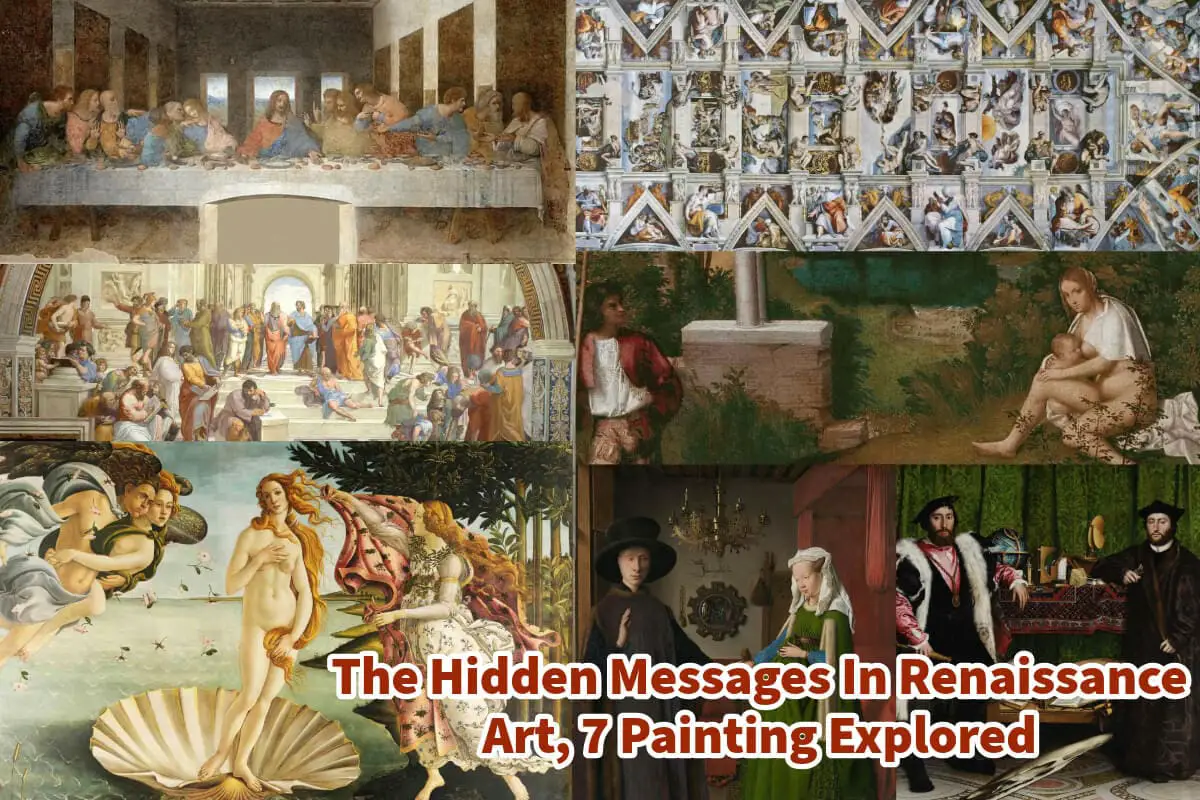Renaissance art is celebrated not only for its breathtaking beauty and technical mastery but also for its layers of meaning and rich symbolism.
Beneath the surface of many Renaissance masterpieces lie hidden messages—encoded through allegory, symbolism, and subtle details—that reveal the artist’s thoughts, the patron’s intentions, or the cultural and political context of the time. These hidden meanings invite viewers to look beyond the obvious and engage with the deeper narratives in the works.
Table of Contents
- The Renaissance: A Time of Symbolism and Subtlety, 7 Works of Art Explored
- The Legacy of Hidden Messages in Renaissance Art
- Renaissance: The Art of Discovery
- Related Questions
Read on as we will explore some of the most famous Renaissance paintings, uncover their hidden messages, and analyze how these layers of meaning add depth to the artistry and cultural significance of the period.
The Renaissance: A Time of Symbolism and Subtlety, 7 Works of Art Explored
The Renaissance (14th to 17th century) was a time of intellectual revival, deeply influenced by classical antiquity, humanism, and religious faith. Artists used symbolism to communicate complex ideas, often blending Christian theology, Greco-Roman mythology, and contemporary politics into their works. Symbolism also reflected the artists’ ingenuity, allowing them to include hidden narratives that could be understood only by a knowledgeable audience.
Whether these messages were religious, political, or personal, they added a layer of intrigue and ensured the art would resonate on multiple levels.
1. Leonardo da Vinci’s The Last Supper
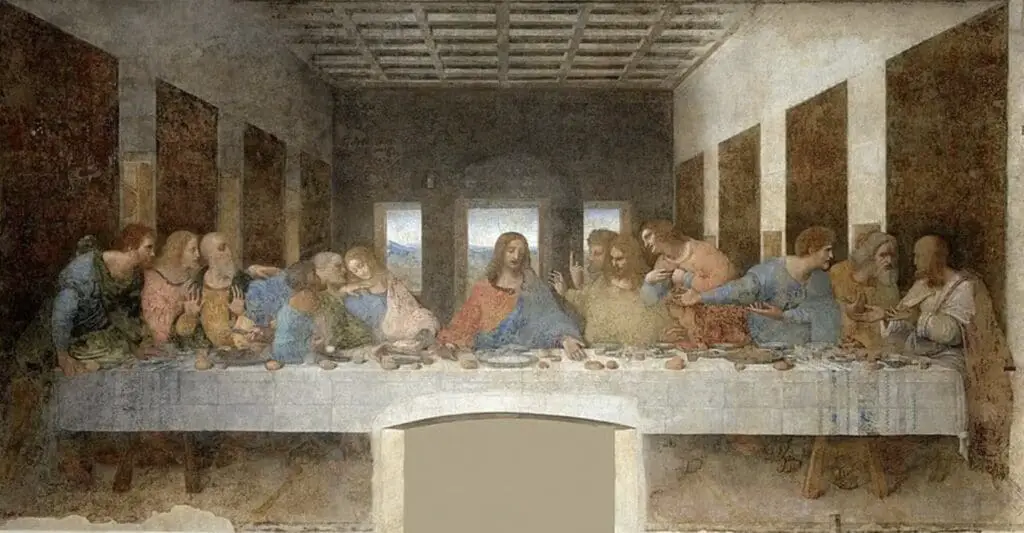
One of the most iconic Renaissance works, Leonardo da Vinci’s The Last Supper (1495–1498), depicts Jesus announcing that one of his disciples will betray him. While the painting is widely recognized for its dramatic composition and emotional intensity, it is also filled with hidden messages and symbolism.
Hidden Messages
- Numerical Symbolism: The number three, symbolizing the Holy Trinity, appears repeatedly. The disciples are grouped into three clusters, and Jesus forms a triangular shape with his body.
- Judas’ Betrayal: Judas, often identified as the betrayer, is placed in the shadow, holding a small bag (likely referencing the silver he received for betraying Jesus). His hand reaching toward the same dish as Jesus is a subtle nod to the Gospel account.
- Jesus as the Central Figure: Jesus is framed by an open window that resembles a halo, reinforcing his divine nature. His calm expression contrasts with the chaos around him, symbolizing his role as a beacon of peace.
Why It Matters
Da Vinci’s symbolism transforms a well-known Biblical story into a multi-layered narrative, inviting viewers to contemplate theological and moral themes.
2. Botticelli’s The Birth of Venus
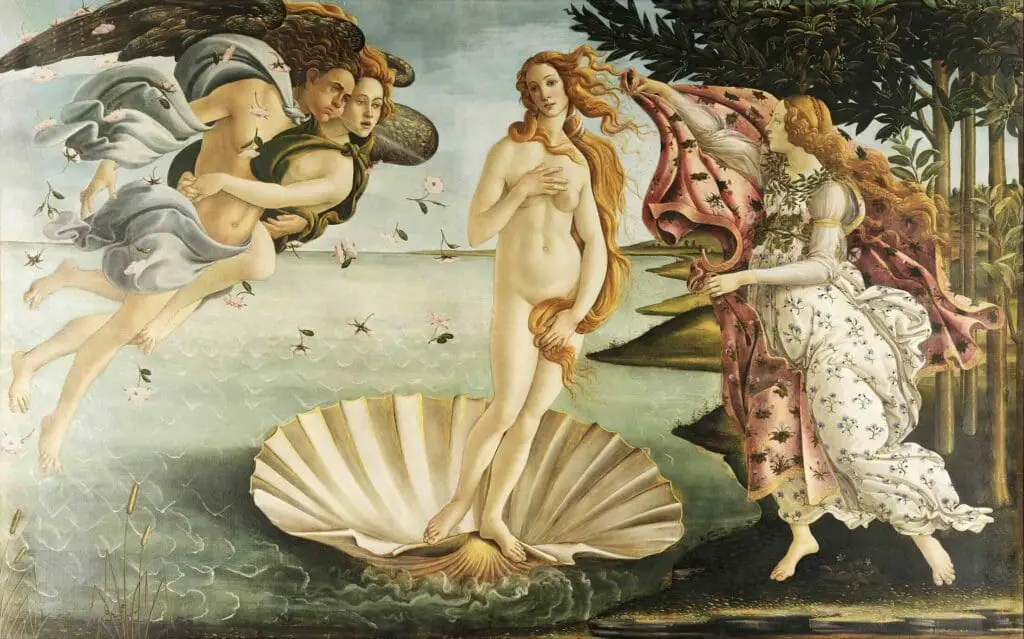
Sandro Botticelli’s The Birth of Venus (c. 1485) is an iconic representation of mythological beauty. While it depicts the goddess Venus emerging from the sea, its hidden meanings go far beyond its mythological subject.
Hidden Messages
- Neoplatonism: Botticelli’s painting reflects Neoplatonic ideas, blending pagan mythology with Christian spirituality. Venus is the classical goddess of love and an allegory for divine love and purity.
- The Laurel Tree: The trees framing the painting are laurel trees, referencing the Medici family, Botticelli’s patrons. This subtle nod underscores their power and influence during the Renaissance.
- The Zephyrs: The wind gods blowing Venus ashore symbolize the transformative power of love, guiding humanity from chaos to order.
Why It Matters
Through its symbolic layers, The Birth of Venus becomes more than a mythological scene; it’s a philosophical exploration of love, beauty, and spiritual transcendence.
3. Michelangelo’s Sistine Chapel Ceiling
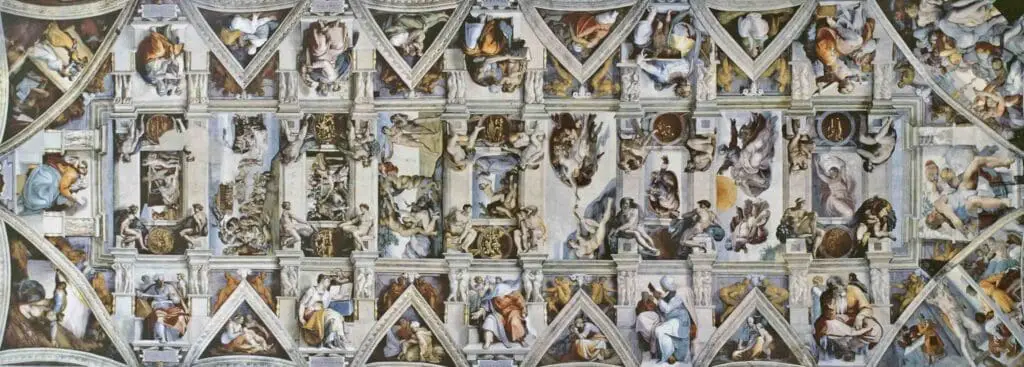
Michelangelo’s Sistine Chapel ceiling (1508–1512) is a monumental work filled with Biblical scenes and allegorical figures. While its primary narrative comes from the Book of Genesis, it also contains intricate symbolism and hidden messages.
Hidden Messages
- Anatomical Imagery: Some scholars argue that Michelangelo, interested in anatomy, embedded anatomical references within the ceiling. For example, the shape of God’s cloak in The Creation of Adam closely resembles a human brain, symbolizing divine wisdom.
- Duality of Good and Evil: The juxtaposition of heroic and flawed figures reflects humanity’s moral struggles. This duality underscores Renaissance humanism’s focus on the complexity of the human experience.
- Sybils and Prophets: Michelangelo included pagan sibyls alongside Biblical prophets, suggesting that divine truth transcends religious boundaries.
Why It Matters
Michelangelo’s use of hidden messages elevates the Sistine Chapel ceiling into a profound commentary on human nature, spirituality, and the search for truth.
4. Raphael’s The School of Athens
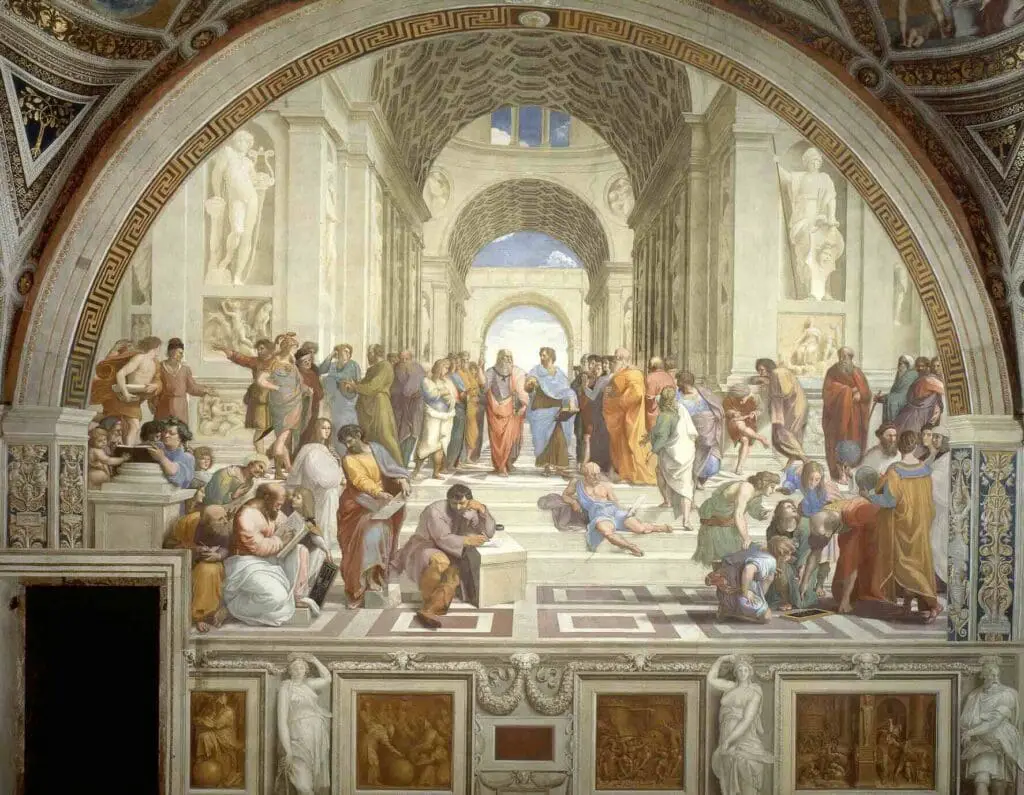
Raphael’s The School of Athens (1509–1511) celebrates philosophy and learning, featuring a gathering of great thinkers from classical antiquity. While its surface meaning is clear, the painting includes subtle messages and personal touches.
Hidden Messages
- Philosophical Allegory: The central figures, Plato and Aristotle, symbolize contrasting philosophical approaches—idealism and empiricism. Their gestures (Plato pointing upward, Aristotle gesturing horizontally) reinforce this duality.
- Self-Portrait: Raphael included himself among the philosophers, subtly asserting his role as a Renaissance thinker and artist.
- Tribute to Michelangelo: The brooding figure of Heraclitus, modeled after Michelangelo, acknowledges the artistic rivalry and mutual respect between the two masters.
Why It Matters
By blending personal, philosophical, and cultural symbolism, Raphael’s masterpiece reflects the Renaissance’s intellectual spirit.
5. Jan van Eyck’s The Arnolfini Portrait
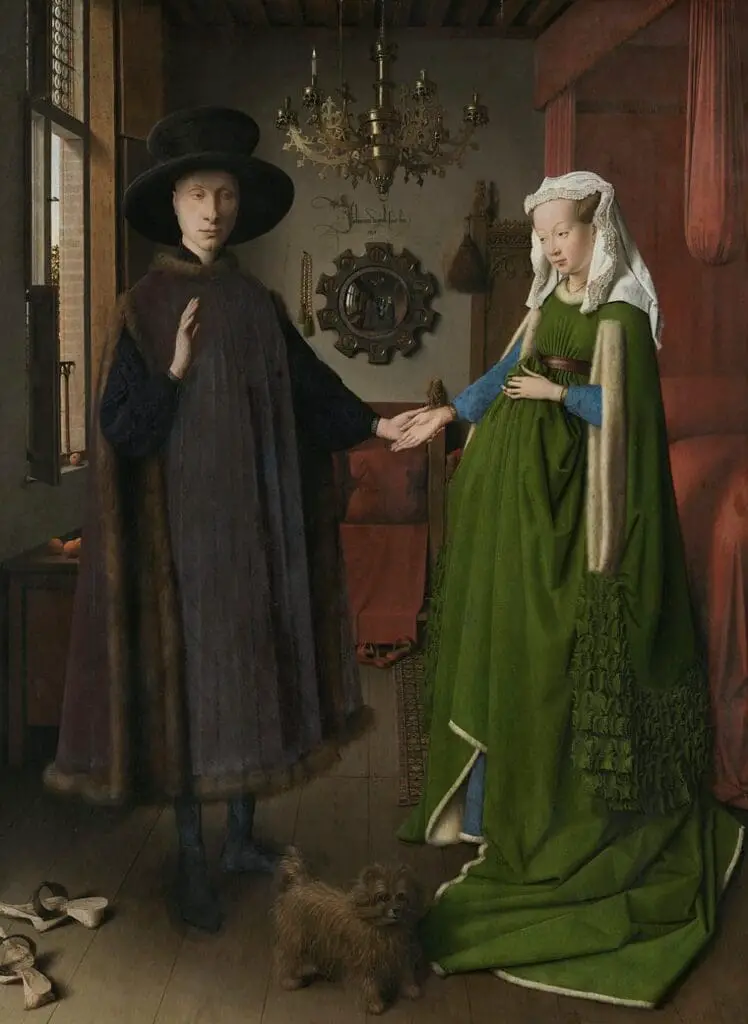
Jan van Eyck’s The Arnolfini Portrait (1434) is a highly detailed work depicting a wealthy couple. Beyond its striking realism, it is packed with hidden symbols and messages.
Hidden Messages
- The Mirror: A convex mirror in the background reflects two additional figures, one of whom may be Van Eyck himself. This detail suggests the presence of witnesses, possibly alluding to the painting’s function as a legal document.
- Fertility Symbols: The green dress and prominent placement of the woman’s belly suggest fertility. At the time it was fashionable for women to have padded bellies which was thought to make them look more fashionable.
- Religious Symbolism: A single lit candle and prayer beads hint at divine presence, blessing the union.
- The Artist’s Signature: Van Eyck inscribed “Jan van Eyck was here” above the mirror, blurring the line between art and reality.
Why It Matters
Van Eyck’s subtle details encourage viewers to question the nature of reality, identity, and the artist’s role in storytelling.
6. Hans Holbein’s The Ambassadors
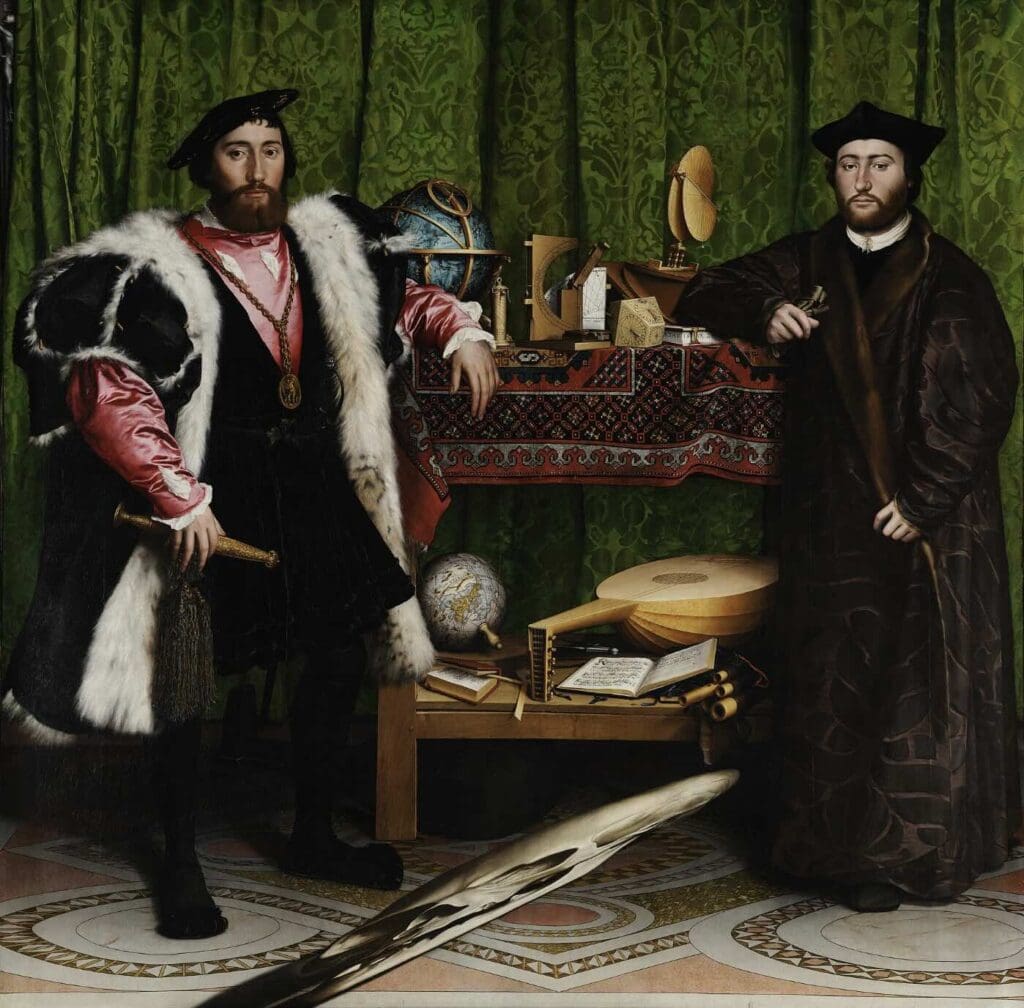
Hans Holbein’s The Ambassadors (1533) is a double portrait of two French diplomats renowned for its enigmatic symbolism.
Hidden Messages
- The Anamorphic Skull: A distorted skull lies at the bottom of the painting, visible only from a specific angle. This memento mori reminds viewers of mortality, even amidst wealth and power.
- Objects on the Table: The scientific instruments and books symbolize knowledge and exploration, while the lute with a broken string suggests the fragility of human endeavors.
- Religious Tension: The inclusion of a crucifix and secular items reflects the religious conflicts of the time, particularly between Protestantism and Catholicism.
Why It Matters
Holbein’s intricate symbolism transforms a portrait into a profound meditation on mortality, knowledge, and the human condition.
7. Giorgione’s The Tempest
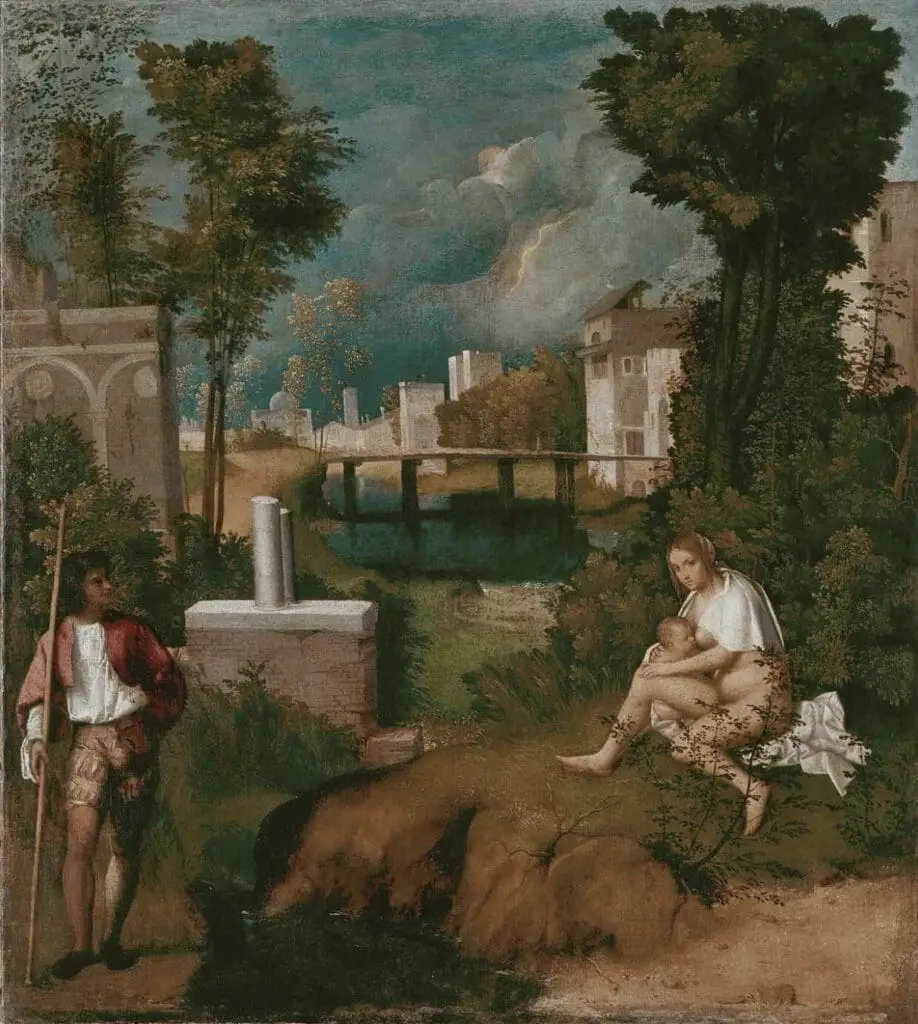
Giorgione’s The Tempest (c. 1508) is a mysterious painting that has puzzled art historians for centuries. Its symbolic meaning remains open to interpretation.
Hidden Messages
- The Figures: The male figure, possibly a soldier or shepherd, and the nursing woman evoke themes of protection, motherhood, and the natural world.
- The Storm: The approaching storm in the background may symbolize impending danger or divine intervention.
- Ambiguity: The painting’s lack of a straightforward narrative invites viewers to project their interpretations, making it a precursor to modern art’s open-ended symbolism.
Why It Matters
The Tempest highlights the Renaissance’s shift toward individual interpretation, blending naturalism with mystery.
The Legacy of Hidden Messages in Renaissance Art
The hidden messages in Renaissance art reveal the era’s intellectual depth and the artists’ mastery of visual storytelling. These works were designed not only to be admired but also to provoke thought, encourage reflection, and engage audiences on multiple levels.
Why Hidden Symbolism Endures
- Engagement: Symbolism invites viewers to look closer, deepening their connection to the art.
- Universal Themes: Many hidden messages address timeless themes such as faith, mortality, love, and power.
- Cultural Insight: Understanding these symbols provides a window into the Renaissance era’s beliefs, values, and tensions.
Renaissance: The Art of Discovery
The Renaissance was a golden age of art, rich with symbolism and hidden meanings that continue to captivate and intrigue. By embedding layers of allegory, artists transformed their works into dynamic narratives that speak to viewers’ intellect and imagination.
Exploring the hidden messages in Renaissance art reminds us of the enduring power of creativity and the profound ways art can communicate across centuries. Whether viewed for their beauty, symbolism, or historical significance, these masterpieces remain timeless treasures, inspiring.
Anita Louise Art is dedicated to art education, great artists, and inspiring others to find and create their art. We love art that uplifts and inspires. #ArtToMakeYouSmile! #ArtToMakeYouHappy!
If you are interested to see any of my art, you can find out more by clicking here. If you are interested in what inspires me and my paintings, you can discover more by clicking here.
We have a free newsletter and would love you to be part of our community; you can subscribe to the newsletter by clicking here. If you have any questions, I would be happy to talk to you. You can reach me, Anita, by clicking here.
Subscribe to our Anita Louise Art YouTube Channel filled with great videos and information by clicking here.
Related Questions
Did Michelangelo And Leonardo Know Each Other?
Michelangelo and Leonardo da Vinci knew each other but were considered bitter rivals. Leonardo da Vinci and Michelangelo knew each other, but they did like each other. They were both asked to do a commission on the Council Hall of the Palazzo Vecchio and were supposed to work side-by-side; the project was never completed.
By clicking here, you can learn more by reading Did Michelangelo And Leonardo Know Each Other?.
Michelangelo’s Method To Paint The Sistine Chapel Ceiling
He built a large scaffolding structure that could move around the chapel to paint the ceiling; the painting of the Sistine Chapel was an extremely strenuous work that was a huge personal cost both physically and mentally to Michelangelo.
By clicking here, you can learn more by reading Michelangelo’s Method To Paint The Sistine Chapel Ceiling.
Michelangelo’s Sistine Chapel And His Payment
Michelangelo was paid 3200 gold ducats for his work on the ceiling of the Sistine Chapel, which would have been a very lucrative commission. We know that he stopped work on the ceiling for a while due to his not being paid by the Vatican. Michelangelo liked to give the impression that he was a very poor artist, but records have shown that he died an extremely wealthy man.
By clicking here, you can learn more by reading Michelangelo’s Sistine Chapel And His Payment.

